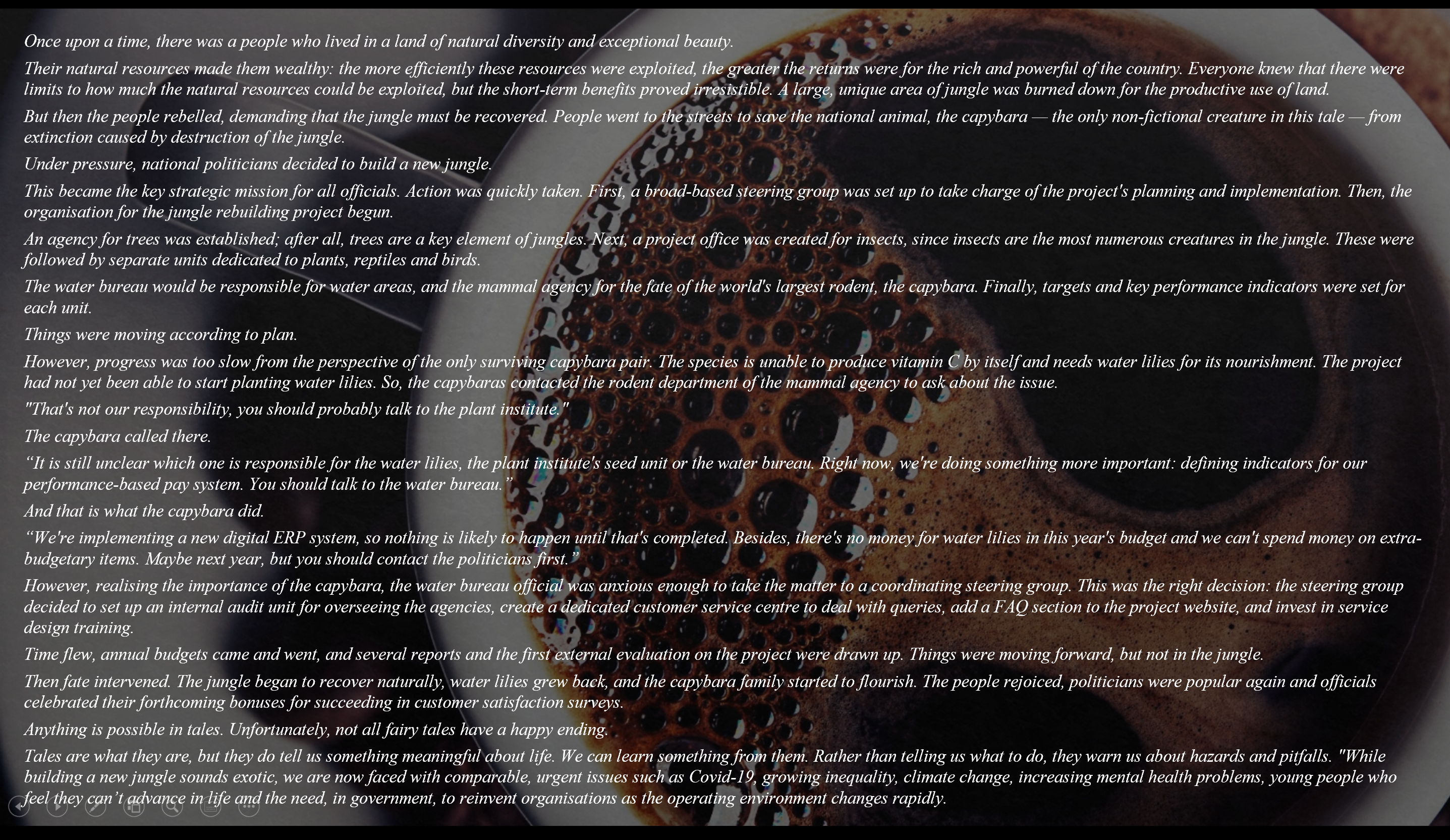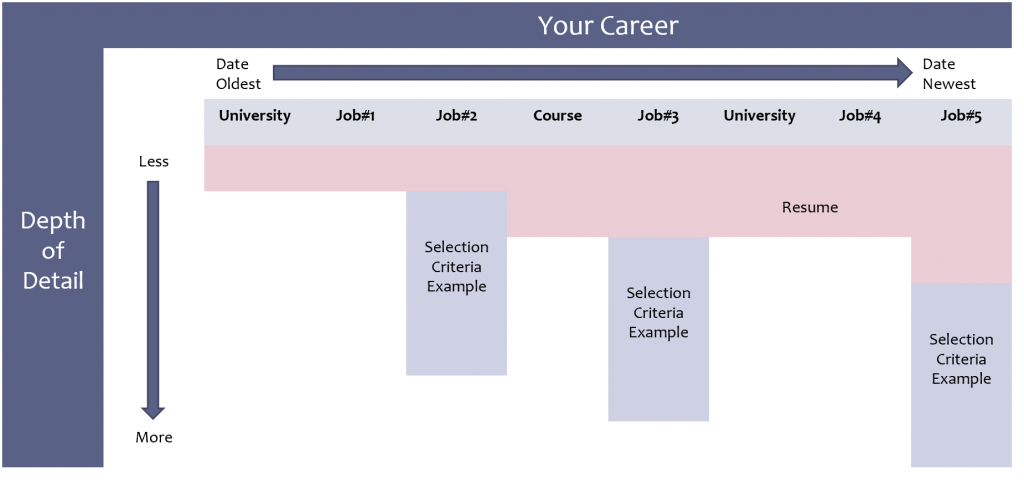A while ago I read a fascinating opinion piece called The challenge of building a jungle | Apolitical written by Olli-Pekka Heinonen.
It reads in part:

The story is used to represent an example of a complex system with variety, interdependence, and rapid pace of change. I love it for the fact it describes the sometimes reality and the sometimes perception of government very well.
In my service experience course I tell the story of building a road to help explain to those coming from a service background, how government is different to the service context.
Linked below if you want to listen:
Building a road part #1
Building a road part #2
It is equally baffling as for the poor Capybara.
Government versus Business
The business of running a government and delivering on social policy outcomes and services for a population, being fair to everyone in doing so and considering everyone’s diverse needs, is and always will be an incredibly complex thing. That’s where government and business deviate. Government cannot be driven by profit and efficiency; everyone needs to be considered. A business could run a public transport system, but areas of low demand would not receive service as it would be unprofitable whereas a government is obliged to deliver a service.
The difference between government and business is not new. Governments are responsible for social policy delivery using public money so must ensure the highest standards of accountability. This extends to recruiting.
Private companies
In business, recruiters can make decisions about who they employ quickly and easily, including if that involves family members (husbands, wives, children, parents). Companies can also enter agreements with other companies to further their collective business interests, including if those companies may belong to other family members or friends.
Business employers are bound by the same laws as government around fair work and unfair dismissal however many new employees are initially engaged on a short-term basis either casually or under contract, at a higher hourly rate. Permanency or a stake in the company comes later with proven performance.
Government
Historically government has been viewed as a secure, long term employment model. Decades ago it was not uncommon for people to be in the same government department/role for 40-50 years and then retire.
As I’ve said in other blogs Career Change Selection Criteria – How To Write One, in times gone by to be a government policy officer you needed policy development experience. That made governments like a closed shop. To get policy experience you almost needed to start as a graduate and work your way in. That has changed in recent years, and no longer do you need policy experience; you need communication, analysis, and advice skills. Not only has the applicant base broadened, but government must give everyone an equal chance of applying.
It is public money that pays wages so can you imagine if a government managers children were employed based on a one-page resume? It’s the same as government procurement; governments cannot just pick a vendor for a million-dollar IT project, there must be tenders, assessments, transparency, and accountability. It makes the ‘process’ seem to be king, and that governments are slow to respond but it is a function of the accountability taxpayers rightly expect.
Go Beyond the Blog. Learn more. Enrol now!
Increase your learning by drawing on 20 years of experience captured in a few online courses.
Old Government, New Government
Perception of government aside, government in some places has changed a long time ago; in other places it is changing now.
Where I work it is business as usual to be talking about customer or user experience, digital by default, data analysis driven insights and planning, using the customer experience lab, having daily stand ups, and running projects in sprints using agile methodology. Meeting rooms are video/audio enabled for Teams by default, everyone has a webcam and headset (and did before COVID) and Teams calls involving dozens of people working at remote locations to delivery projects is a daily thing. Connectivity and productivity are available on mobile devices, technology adoption is becoming more agile, and projects are rapidly moving away from full scale/waterfall delivery big bang projects.
Government Misconceptions (new and old)
The biggest misconception of the public service…that command and control don’t happen. Structure (rank) exists and functions every day; organisations are based on levels and grades. Executives and manages make decisions every day – when they are needed.
The difference is in how some “decisions are made” or more accurately how results are delivered. Decision making and service delivery often involves consultation and is a journey. The nature of the decisions is different, so consultation needs to occur.
From my service experience course:
You’re used to being responsible for an investigation or incident or project or an operation, usually a discrete piece of work.
You have your skill set and if you need someone else’s skill set, you access them.
Everyone you need is working to the same goal, your goal.
In the public service, you are responsible for your part of a project or task, and everyone else is responsible for their part; and sometimes everyone is trying to achieve their own goal(s) – which are all equally important just not necessarily compatible.
In government, projects are often framed the same way, but individuals have influence over their own goals and objectives in the larger project.
The outcomes are also less concrete such as project that aim to deliver social policy outcomes.
At times, individual goals try to take precedence over the overall project.
And the way to manage it going forward is communication, consultation and going on the journey.
The other most obvious and enduring difference between services and government is how change is managed.
You’re used to being told “From today we are doing this ‘thing’ this way. Yes, we did it differently yesterday, but that was yesterday, and this is today so get used to it”.
Change management in the public service is a little more subtle and finessed. There are even people whose job title is change manager and yes, they manage change.
That involves giving people advice of the new change that’s coming, informing them if/how it will affect them, getting their input, considering their input, consulting with them again and working with them after the change occurs.
It’s “Just Government”
A comment by someone on a recent Reddit blog caught my eye. Their comment included the words “…it’s just government“. It may have triggered me. This was my thoughtfully crafted reply which I did not send but decided to keep for here.
It is just government?
- $8.5 B annual operating budget.
- $27.5 B project budget over 5 years.
- $55 B assets managed and maintained.
- About 4M customers, 12M transactions a year of which 75% are online and Certified against International Customer Service Standards.
- Customer experience labs, user expense testing.
- 1B ton of freight moved across the network.
- Data driven organisation with analytics across all our data in Cloud databases.
- 8,500 staff.
- 200 M passenger trips on public transport.
- Geographic area of 1.85 M km2 where service delivery for all communities and people (young, old, indigenous etc) must occur; not just the easy, high value ones a profit can be made from.
- But yeah it’s “just government” it doesn’t resemble any private business in any way at all.
That’s the reality of delivering government services. It’s not tea trolleys and reading the paper; that was the 1970’s. I dare say private companies are infinitely more likely to indulge their employees with basics like free tea and coffee than the government. Once again that is taxpayer money so is entirely appropriate, yet the perception is public servants are still sipping public funded tea all day.
The added complexity is the social policy aspect. Governments have to deliver services for all people everywhere. Delivering services to 4 million customers dispersed across 1.85 M km2 to an acceptable standard is not an easy task. No private company would undertake that, there is no profit margin and that’s why we have governments.
Within those customers are:
- First nations people,
- Culturally and linguistically diverse groups,
- Social disadvantaged,
- Financially disadvantaged,
- Educationally disadvantaged,
- Elderly,
- People with disabilities,
- Children,
- People who fall in more than one category.
The operating context includes fast moving technologies and changes (disruptors) that legislation struggles to respond to. There is a reason for that because policy and legislation development is consultative of all of those groups because one decision by a government affects different people in different ways and the outcomes need to be as balanced a possible.
Those are complex processes and decisions which, once again, private companies do not do because it would affect the bottom line and they have the luxury of profit being the bottom line, not equitable service delivery.
End of rant.
So, what have the Capybara, road building and delivering social policy all got to do with government selection criteria?
Nature of Government Selection Criteria
Government selection criteria ask you to give a lot of information in your responses. This is because everyone needs to be treated equally, and people from outside government need the opportunity to display they have the competencies government needs. This is especially as it journeys beyond old style government described above. It also needs to ensure fairness, transparency, and accountability.
Could the “selection criteria process” be improved? Almost certainly yes. Is it likely the “selection criteria process” will change to a private industry/resume only style model? I cannot see a time that will happen.
Are you trying to understand why the process is how it is? If you stop wrestling with the idea of what a selection criteria is, and just think about it as you need to give some examples from your experience like you would in your resume. In addition to saying what the example is, you also need to describe it like a case study so the reader can objectively sit at a distance and understand what you did as if they were there. That’s what a government selection criteria response is.
In The Ultimate Selection Criteria Blog I use this visual to show the difference.

Your resume may just talk about a project with an outcome; your selection criteria needs to talk about the journey from project to outcome. What you did, how, why, what issues you dealt with and how, what you learned; a mini case study. You do this using the STAR model:
- ST – Situation/Task (10-20% of your response)
- Where you were and what you were doing
- You would have this in your resume.
- A – Action (60-80% of your response)
- Telling the story in a way the reader can see what you did as if they were there
- Think of it as a case study.
- R – Result (10-20% of your response)
- Outcome
- You would have this in your resume.
On the upside, by contributing this amount of content before interviews, you are cutting down on the number of interviews you need to do. In private industry it is possible to be called back for five, six or seven interviews which is a big commitment of time.
To efficiently write a selection criteria response using the STAR Method is actually a quicker process.
It might be a foreign and weird way to apply for a job, but it is simply an extension on what you already do, and, is an easily learnable process that cuts down on number of interviews you have to do later.
Share this post
